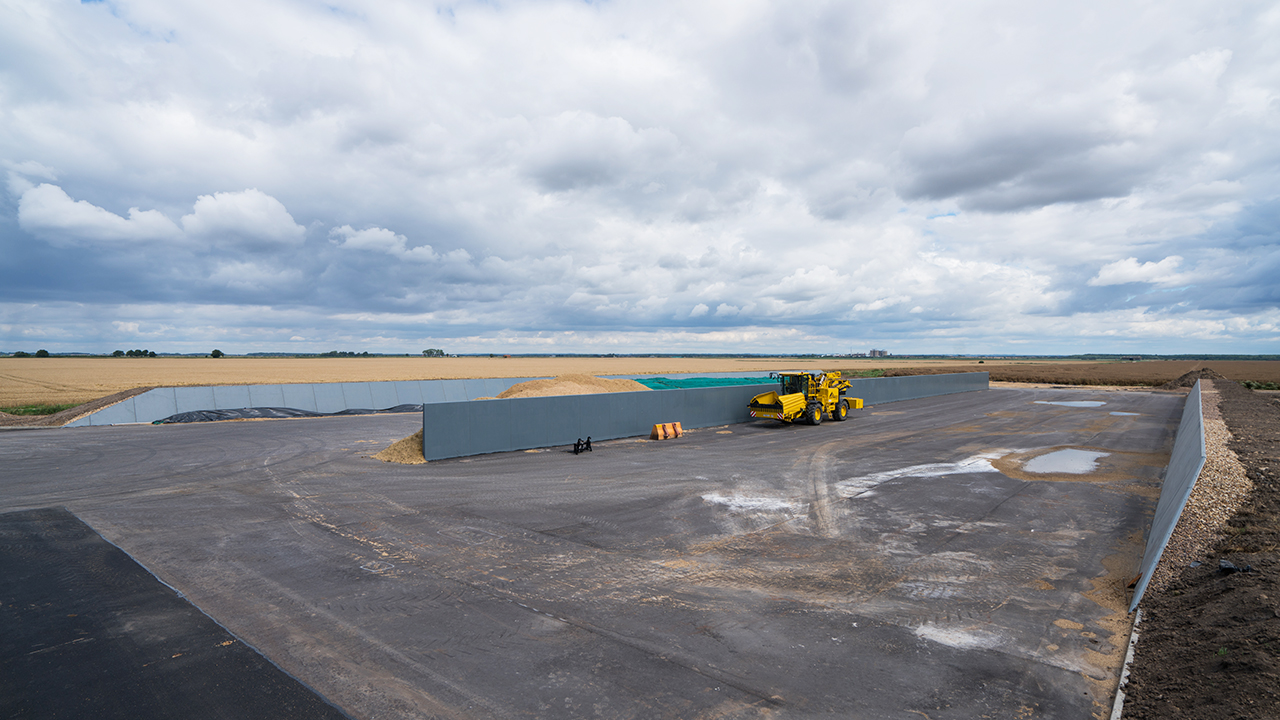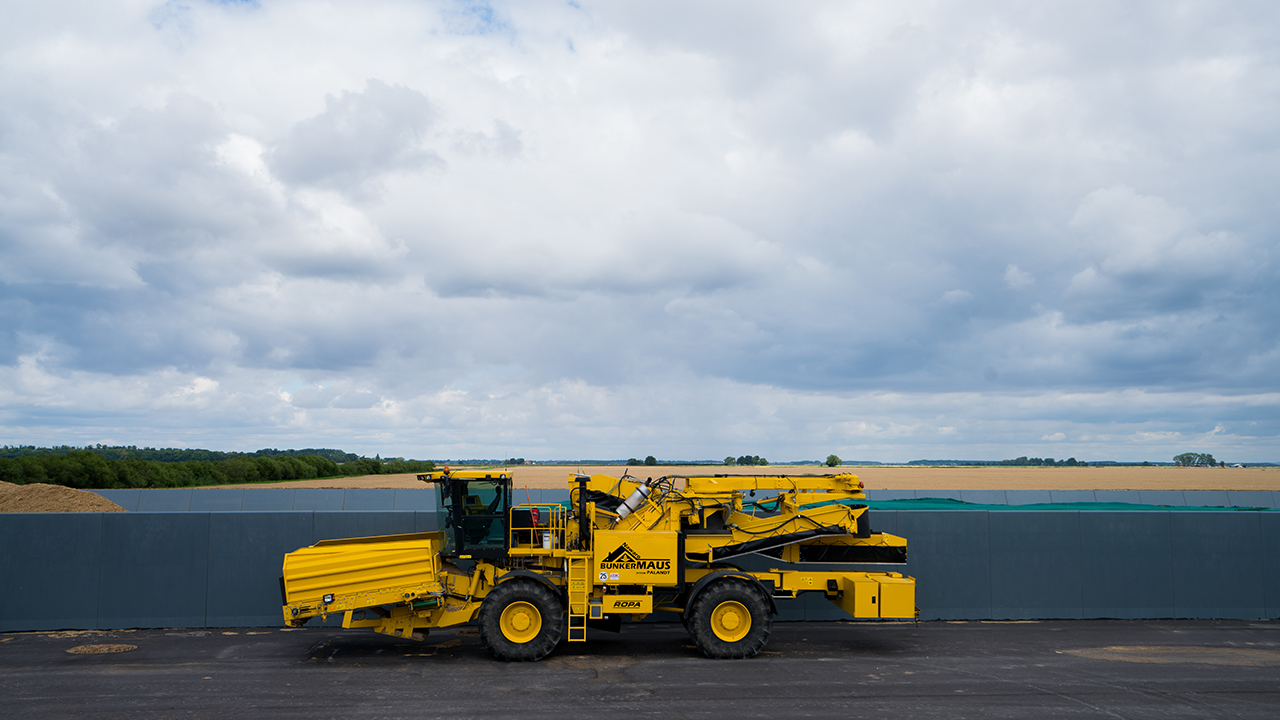Silage clamp design and installation to comply with the UK silage clamp regulations (SSAFO Regs (UK)) is an essential component of modern anaerobic digestion plants.
What Is A Silage Clamp?
Silage clamps are concrete panel structures that serve as the wall and base for silage pits, which are used to store covered grass, maize, or whole crop wheat. They are typically covered by an airtight plastic sheet that is placed over the crop being stored, providing a food source for dairy cows or feed for a biogas reactor.
Planning for a New Silage Clamp
The construction of a silage clamp requires careful planning. You need to know how much space you will need for the clamp. A silage clamp over 465 square metres generally requires a full planning submission.
You also need to consider how to handle the effluent. There are important features to consider when deciding on a clamp design. These features should not be overlooked. In addition to the design, you should consider the materials which will be used.
Clamp Design
When choosing the right silage clamp, consider the site and the potential for development. If the site is near a building, choose a site where it is alongside but avoid reducing the safe access to the building.
Moreover, you should make sure that the location is not on built-up, backfilled, or sloping ground.
Your local EA office should help you in this regard. Once you've got all the details, you can then hire a contractor to build your silage clamp.
The design of your clamp should be easy to access. The back wall should be free from obstruction. It should be angled away from the prevailing wind. It can be at ground level or below the ground subject to suitable access ramps, depending on your needs.
The clamp must be installed so that leachate does not leak into groundwater or local streams. The joint sealant needs to be carefully chosen for its ability to resist chemical attack from the leachate attack the joint between the base and walls.
The design should also be appropriate for the avoidance of carbon dioxide emissions during its construction and use. Ensiling practices will be equally important. Follow the advice of your regulatory body and from farming standards organisations. It may be a requirement that thin layers of no more than fifteen centimetres thick must be formed during filling. In the UK the SSAFO regulations will apply.
Clamp Construction
The construction of silage clamps is becoming a specialist skill. As a result, external contractors should be hired to complete the whole project from design to commissioning.
Many silage clamps require significant earthworks, which should be planned carefully to minimize their visual impact. The excavated material may be used to build sloping earth-bund walls around the low parts of the clamp.
The construction of a silage clamp must meet all the local environmental agency requirements.
From the autumn of 2022 new Uk regulations require that anaerobic digestion plant clamps must be certified by an engineer, and the first use must be reported 14 days before their intended use.
Clamp Size Calculations
When choosing a clamp, consider the dimensions. As already stated, if the clamp is going to cover more than 465 square metres, then it requires full planning permission. A silage clamp with more than 500 square feet generally requires effluent storage.
A silage clamp that is too narrow will expose the face of the silage to oxygen for an extended period of time, which may adversely affect the quality of the silage. The width of the clamp must also be appropriate for the size of the silage store overall.
Use of Precast Concrete Panels
Precast concrete panels are a great option for silage clamps. Concrete panels can be brought to the site and rapidly fixed to the base foundations. Concrete panels are easy to install and come in different strengths and thicknesses.
You can also install vertical cantilever walls on concrete foundations.
Besides being important to the biogas industry, silage clamps also play a key role in agricultural biogas plants. While they are essential in terms of AD feedstocks, they have a big downside because they can also pose a risk of significant pollution of the local groundwater and watercourses.
Always Take Care to Maintain Your Clamps
 If the clamps fail to meet the regulatory requirements and water pollution occurs, the environmental regulators can take action. The polluter pays principle applies in this case. You have to follow all regulations to avoid causing watercourse pollution and ignorance of a pollution event is no defence.
If the clamps fail to meet the regulatory requirements and water pollution occurs, the environmental regulators can take action. The polluter pays principle applies in this case. You have to follow all regulations to avoid causing watercourse pollution and ignorance of a pollution event is no defence.
Proper design of silage clamps is crucial in preventing major problems which can often occur within three to four years. Before purchasing clamps, always ask for professional advice. Also, make sure to check all safety requirements and perform routine maintenance to ensure safe operation and to extend their life. This way, you can expect your silage clamp to last at least 20 years and produce quality silage.
Considering the longevity of your clamp it really is worth taking the time to make sure it is built properly.
Now having explained our thoughts on these large, but humble, structures we provide below our original archive article on the subject written in May 2018, but still very relevant today:
Silage Clamp Design and Installation by JP Concrete Essential to Powering 10,400 Homes
We are pleased to post the Press Release provided by JP Concrete below, and emphasise that such installations are essential to the provision of reliable 24/7 powering of 10,400 Homes, via the national grid. The humble silage clamp, so often forgotten when biogas production is discussed is the key to storing energy from annual harvests, so that the energy-producing AD process can be fed a consistent feedstock.
 That very consistency of the food provided for the bacteria (also including archaea) which drive biogas production, is what ensures that power is available to those homes throughout the coldest days of winter, and hottest summer heatwaves.
That very consistency of the food provided for the bacteria (also including archaea) which drive biogas production, is what ensures that power is available to those homes throughout the coldest days of winter, and hottest summer heatwaves.
Designing and building silage clamps to the lowest possible budgets, which will provide a seal against the loss of liquids into the environment is not an easy one to pull off either. During silage clamp design the regulations have to be complied with, and the seal has to be maintained over the years, so this news of seven such examples is indeed noteworthy!
Watch our taster video about this page, which is located immediately below. BUT, we do hope you will scroll on down, after watching and enjoy reading the full article.
Press Release:
JP Concrete Silage Clamp Design provides Beeswax Dyson Farming with more AD and harvest storage options
JP Concrete has completed a total of seven silage clamps and storage pads for Beeswax Dyson Farming’s AD plants in Lincolnshire that produce almost 5MW, powering 10,400 homes via the National Grid.
The pre-cast retaining wall units from JP Concrete have been installed at the Nocton Fen and Carrington AD plants, as well as at five satellite pad locations in the local area.
The two silage clamps and five 50m x 50m freestanding satellite pads enable Beeswax Dyson Farming to meet Silage Slurry and Agricultural Fuel Oil storage (SSAFO) regulations and provide greater flexibility for its harvesting and storage of energy crops such as maize, and food crops that include rye and barley – as Paul Carrott, Farm Manager at Beeswax Dyson Farming explains:
“Our new satellite pads allow us to use the crops we harvest as and when required – not just for our AD plants, but for general temporary storage. This greatly reduces vehicle journeys around the surrounding villages, meaning less impact during the busy harvest time. On energy crops alone, we harvest 2150 ha annually”.
Beeswax Dyson Farming’s contractors installed the earth bank retaining walls, whilst Modular Cubed (JP Concrete’s sister company) utilised their own 73-tonne truck-mounted crane to install 3m high, 5.6T dividing T-wall sections.
Paul Carrott added:
“The pre-cast products from JP Concrete, which are of excellent quality, were supplied and installed very quickly. The decision was taken to use the existing earth banks on the outer walls of the clamp to provide a base to form new 3m high precast earth bank retaining walls. And because we would be storing a variety of crops, a central dividing wall was constructed using pre-cast modular T-walls, which has certainly improved the way we manage our AD feedstock”.
From both Nocton Fen (Beeswax Dyson Farming’s first AD plant) and Carrington (commissioned in 2016), a very high quality digestate (applied to the land) has significantly increased the land’s fertility and organic matter. This complements the company’s sustainable crop rotation and diversity of cropping to enhance the health of the soil, reduce weeds and improve the utilisation of fixed costs.
Phil Sayers from JP Concrete, commented:
“We aim to provide the AD/agricultural industry with much more than just precast products, offering our experience with design, and via our sister company, Modular Cubed, a complete installation service”.
He added: “Helping Beeswax Dyson Farming implement their sustainable and logistically sound approach to crops, land and renewable energy is work that we are extremely proud of”.
Silage Clamp Design and Construction
Previously, JP Concrete created an all-encompassing storage and safety solution to ensure the smooth and efficient operation of a new AD plant in Reading for meat and vegetable producers Butlers Services. JP Concrete supplied concrete bund walling for three digestate tanks, a silage clamp and a retaining wall for site access.
They also provided all silage clamp design calculations and drafting services, as well as carried out the installation and sealing of the units.
JP Concrete
+44 115 895 8240
www.jpconcrete.co.uk
If you were not convinced that sub-standard silage clamp design and operational practises can create hefty silage clamp costs and even result in fines. Perhaps more importantly for those involved is the fact that, with those fines comes a criminal record for the farmer concerned. With this in mind we have added two excerpts from within the last 5 years in the UK:
Real Costs of Silage Clamps that preserve Silage to allow Aerobic Digestion (Composting) to Occur
Livestock farmers could be losing thousands of pounds a year from poorly clamped silage. Recent figures suggest aerobic deterioration in clamps costs the UK agricultural industry £170m a year. In addition, losses that occur before the clamp is opened (storage losses) could easily add a further £100m a year to the bill. And while many producers will know the cost of production per tonne of fresh or dry matter, few will know the percentage losses between field and feed face … via Guide to assessing your silage clamp for costly losses
The Cost of Non-complaint Silage Clamps that fail to Meet SSAFO Regulations Requirements:
Dorset farmer fined £10,000 for polluting river
A Dorset farmer has been ordered to pay £16,339 in fines and costs for polluting a tributary of the River Divelish with slurry. The case was brought by the Environment Agency.
The pollution was first discovered during a routine inspection of the river on September 20, 2012. Agency officers traced it to Lowbrook Farm, Belchawell near Blandford Forum run by dairy farmer Clifford Yeatman.
Slurry from the defendant’s herd of cows is used to power an anaerobic digester to produce energy. A by-product of this process, ‘digestate’, is stored in the farm’s slurry lagoon along with other farm waste prior to being spread on surrounding land as a fertiliser. via Dorset farmer fined £10,000 for polluting river
We would be pleased to receive any comments you may have about your experience with silage clamp design, installation, and maintenance.








Many people who own homes with air-conditioning fail to realise how much energy is used by these units. If you have an air-conditioned home, consider a greener way of cooling off by saving the energy used to cool the air. Try to save air-conditioning for the hottest days. Keep blinds and drapes drawn during the hottest hours and open windows and doors after the sun goes down. Ceiling fans can also help a great deal!
What is the materials used to start the biogas making process – human dung? This is best. Yes?
Yes. Most people say any sort of dung, or manure.
Dobry artykuł. Podobało mi się czytanie. pls make the silage clamp construction video step by step so that every one understand. Thankz.
A word of warning about the safety of these silage clamps. It’s easy to be unaware that awful Silage Clamp accidents you would never imagine can occur. The url I gave tells of the death of Stephen McMinn entered the area below the silage cover and was overcome by a severe lack of oxygen and tragically died as a result. Other farm workers had laid tyres on top of the plastic sheeting layer to stop it blowing away.